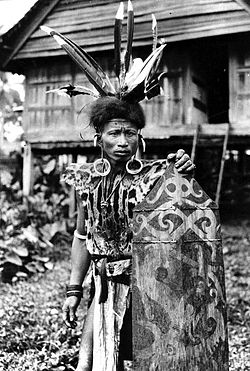Gagong
| Gagong | |
|---|---|

|
|
| Information | |
| Weapon type: | armor |
| Designations: | Gagong, Simong |
| Use: | Protective weapon, professional weapon |
| Region of origin / author: |
Indonesia , ethnic groups from Indonesia |
| Distribution: | Indonesia |
| Handle: | Wood |
| Lists on the subject | |
The Gagong also Simong , War Jacket is an armor from Indonesia.
description
The gagong is used exclusively in battle and is made of animal skin. The area of the abdomen and the skin of the legs are removed from the skin. The head of the animal is often covered with works made of metal or a large mother-of-pearl shell (indon. Bladder). Often a shell is placed a little below the head. According to the religious belief of the Indonesians, the shell serves as a boat for the fallen warrior's soul , which takes him across the river to the realm of the dead. An incision is made in the front which serves as an opening for the wearer's head. This is attached so that the head of the animal from which the gagong is made lies on the wearer's stomach. The back often extends below the wearer's knees . The back can be decorated with feathers from the hornbill (Bucerodtidae). This decoration is only used for warriors who have already participated in battles. Other warriors use a wickerwork ornament. The gagong is seldom used because it is difficult to get suitable animal skins. In some cases, goat skins are used, the long hair on the back of their necks being well suited for this purpose. Black skins are more preferred than whites. Among other things, the skins of bears (Ursidae), dogs and panthers are also used. The gagong is worn less because of its protective properties, but more because of its martial appearance. The gagong is strong enough to fend off a wooden spear, but not a blow with a lance. The Kenyah warriors often attach hornbill skulls as a symbol of successful headhunting on the chest. A pair of skulls for each victim. The gagong is used by ethnic groups in Indonesia.
Individual evidence
- ^ Albert G. van Zonneveld: Traditional weapons of the Indonesian archipelago. C. Zwartenkot Art Books, Leiden 2001, ISBN 90-5450-004-2 , p. 46.
literature
- George Cameron Stone : A Glossary of the Construction, Decoration and Use of Arms and Armor in all Countries and in all Times. Together with some closely related subjects. With an introduction by Donald J. LaRocca. Dover Publications, Mineola NY 1999, ISBN 0-486-40726-8 , p. 242.
- Brooke Low, H. Ling Roth: The Natives of Borneo. Part II. In: The Journal of the Anthropological Institute of Great Britain and Ireland. Vol. 22, 1893, ISSN 0307-3114 , pp. 22-64, here pp. 53-54, JSTOR 2842111 .